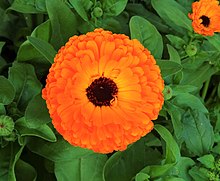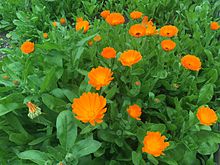Calendula officinalis
| Calendula officinalis | |
|---|---|

| |

| |
| UBC Botanical Garden | |
| Scientific classification | |
| Kingdom: | Plantae |
| Clade: | Tracheophytes |
| Clade: | Angiosperms |
| Clade: | Eudicots |
| Clade: | Asterids |
| Order: | Asterales |
| Family: | Asteraceae |
| Genus: | Calendula |
| Species: | C. officinalis
|
| Binomial name | |
| Calendula officinalis | |
| Synonyms[1] | |
| |

Calendula officinalis, the pot marigold, common marigold, ruddles, Mary's gold or Scotch marigold,
The Latin specific epithet officinalis refers to the plant's medicinal and herbal uses.[9]
Description
Calendula officinalis is a short-lived aromatic
Calendulas are used as food plants by the larvae of some Lepidoptera species including cabbage moth, gothic moth, large yellow underwing, and setaceous Hebrew character.
Cultivation

Calendula officinalis is widely cultivated and can be grown easily in sunny locations in most kinds of soils. Although perennial, it is commonly treated as an annual, particularly in colder regions where its winter survival is poor, and in hot summer locations where it also does not survive.

Calendulas are considered by many gardening experts as among the easiest and most versatile flowers to grow in a garden, especially because they tolerate most soils. In temperate climates, seeds are sown in spring for blooms that last throughout the summer and well into the fall. In areas of limited winter freezing, seeds are sown in autumn for winter color. Plants will wither in subtropical summer. Seeds will germinate freely in sunny or half-sunny locations, but plants do best if planted in sunny locations with rich, well-drained soil. Pot marigolds typically bloom quickly from seed (in under two months) in bright yellows, golds, and oranges.
Leaves are spirally arranged, 5–18 cm (2–7 in) long, simple, and slightly hairy. The flower heads range from pastel yellow to deep orange, and are 3–7 cm (1+1⁄4–2+3⁄4 in) across, with both ray florets and disc florets. Most cultivars have a spicy aroma. It is recommended to deadhead (remove dying flower heads) the plants regularly to maintain even blossom production.
Cultivars
Numerous cultivars have been selected to showcase a wide range of variations, spanning from pale yellow to orange-red, and with 'double' or 'semi-double' flowerheads with ray florets replacing some or all of the disc florets. Examples include 'Alpha' (deep orange), 'Jane Harmony', 'Sun Glow' (bright yellow), 'Lemon' (pale yellow), 'Orange Prince' (orange), 'Indian Prince' (dark orange-red), 'Pink Surprise' (double, with inner florets darker than outer florets), 'Green-heart Gold' (double, bright yellow), 'Apricot Pygmy' (double light peach) and 'Chrysantha' (yellow, double). Additionally, the cultivar 'Variegata' boasts yellow
The cultivar group 'Fiesta Gitana' has been honoured with the Royal Horticultural Society's Award of Garden Merit.[10][11]
Uses
Pot marigold florets are
Flowers were used in
Marigold leaves can also be made into a poultice that is believed to help scratches and shallow cuts to heal faster, and to help prevent infection.[13] It has also been used in eye drops.[12]
Constituents
The petals and pollen of Calendula officinalis contain
Moreover, the flowers of Calendula officinalis contain
Potential pharmacology
Plant pharmacological studies have suggested that Calendula extracts may have anti-viral, anti-
References
- ^ The Plant List, Calendula officinalis L.
- ^ "Calendula officinalis". Germplasm Resources Information Network. Agricultural Research Service, United States Department of Agriculture.
- ^ a b c The New RHS Dictionary of Gardening 1: 462.
- ^ a b Interactive Flora of NW Europe: Calendula officinalis[permanent dead link]. eti.uva.nl
- ^ a b "Calendula officinalis – L." Plants For A Future. June 2004. Retrieved 2007-12-19.
- ^ Flora of China, 金盏菊 jin zhan ju Calendula officinalis Linnaeus, Sp. Pl. 2: 921. 1753.
- ^ Flora of North America, Calendula officinalis Linnaeus
- ^ Altervista Flora Italiana, Calendola medicinale Calendula officinalis L.
- ISBN 978-1845337315.
- ^ "RHS Plantfinder - Calendula officinalis Fiesta Gitana Group". Retrieved 12 January 2018.
- ^ "AGM Plants - Ornamental" (PDF). Royal Horticultural Society. July 2017. p. 13. Retrieved 6 February 2018.
- ^ OCLC 560560606.
- PMID 26231862.
- ^ National Institutes of Health. "Calendula". Herbs and Supplements. U.S. National Library of Medicine. Retrieved 2007-12-19.
- PMID 17190444.
- PMID 11456093.
- ^ Manke Natchigal, A.; Oliveira Stringheta, A.C.; Corrêa Bertoldi, M.; Stringheta, P.C. (2012). "QUANTIFICATION AND CHARACTERIZATION OF LUTEIN FROM TAGETES (TAGETES PATULA L.) AND CALENDULA (CALENDULA OFFICINALIS L.) FLOWERS". Acta Hortic. 939, 309–314. Archived from the original on 14 May 2021. Retrieved 3 July 2019.
- PMID 16677386.
- PMID 22789794.
Further reading
- Aro, A.A.; Perez, M.O.; Vieira, C.P. (February 2015). "Effect of Calendula Officinalis Cream on Achilles Tendon Healing". The Anatomical Record. 298 (2): 428–435. S2CID 25094028.
External links
 Media related to Calendula officinalis at Wikimedia Commons
Media related to Calendula officinalis at Wikimedia Commons
